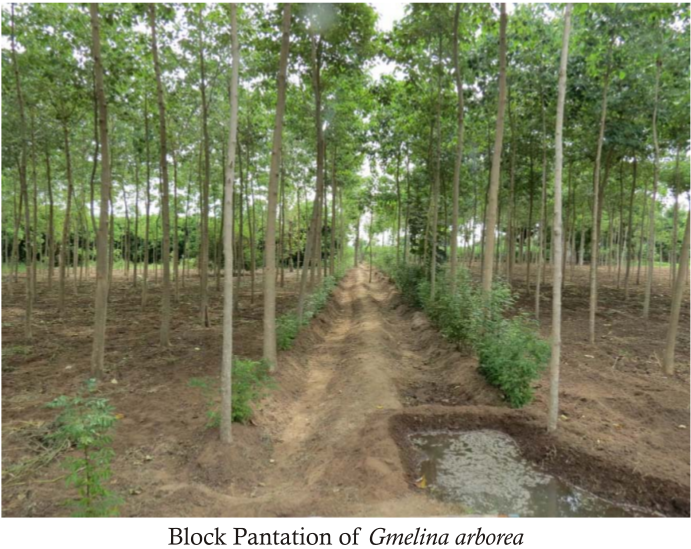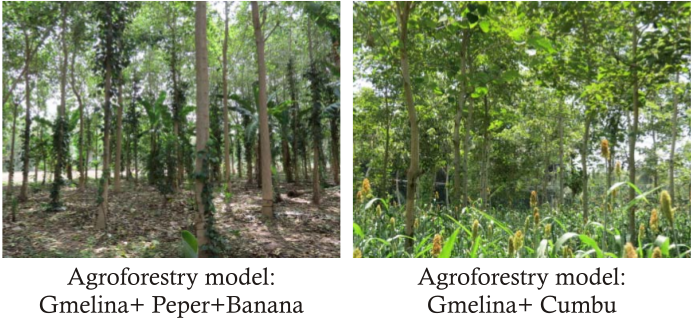Gmelina arborea
Gmelina arborea
Site factors
Gmelina arborea is well adaptable to a wide range of soil and climatic conditions. It is a hardy plant and can be grown in both tropical and subtropical conditions. It grows up very well in red sandy loam soil with the pH of 5-8 and a high soil depth. It grows at an elevation of 0-1200 m MSL. it comes up very well humid climate with the optimum temperature range from 20-38 oC. The annual rainfall requirement is 750-4500 mm. It grows very well in the high sunshine with low shade areas.
Planting stock
The Gmelina arborea tree improvement programme was initiated in India during early 1990. Improved accessions and seeds from the clonal seed orchard is available in Rain Forest Research Institute, Jorhat. The seeds from superior CPTs are available at IFGTB, Coimbatore.
Seed collection, processing and Nursery techniques
The mature fruits may fall from the tree while they are still green. Green fruits turn yellow within a week and after about two weeks from falling, they turn brown and black after about three weeks. It is best to collect the fruits when they are still green or yellow, as germination capacity of brown and especially black fruits is low. As all fruits do not fall and mature at the same time, fruits should be collected frequently, e.g. twice every week during the collection period, that may stretch over several months.
Transport of fruits to the processing site should be in open baskets or nets, not in plastic bags. In order to avoid fermentation, fruits should be brought to the cleaning area within 24 hours. This is especially important for fully ripe (yellow and brown fruits). As much care as possible should be taken to avoid damage to the fruits, since fermentation is more likely to start among damaged fruits. At the processing site, the fruits should be sorted into those that are ready for immediate processing (yellow and brown colour) and green and green-yellow fruits, which will benefit from after-ripening. After-ripening is done in the shade by spreading the fruits in a 10-15 cm thick layer until they have turned yellow. This may take up to one week. Depulping of small quantities of fruits can be done manually by mashing the fruits until the pulp is loose from the stone, and rinsing with water. For larger quantities of fruits depulping is normally done in a coffee-depulper. Soaking the fruits in water for 24 hours before depulping will facilitate the process. After depulping, the fruits are spread out on a wire-mesh tray and rinsed with water to remove juice and pulp. Normally traces of pulp will remain on the stones after depulping and further cleaning or polishing of the stones is required. This can be done either manually by rubbing the stones with sand and water or mechanically (also with sand) in a concrete mixer. Finally the stones are washed and dried well in the sun.
The seeds have no dormancy, and no pretreatment is required. However, soaking of the seed in cold water for 24-48 hours before sowing is recommended.
Gmelina arborea is propagated by both seeds and vegetative methods. Seeds are showed directly in the root trainer or raised beds can be 0.6m in height, 1m in within convenient length. The bed should be filled with sand up to height of 0.5 m. The seeds are closely placed the bed in a rows with a gap of 5cm. The beds are to be watered twice in a day with the help of rose cane. One kg of Gmelina seeds contain about 1500-2000 seeds. The size of the seeds varies between the trees. Seeds normally germinate quickly and at high levels. Often the germination will be above 100% as more than one seed will germinate from each stone. The optimal temperature for germination is about 30oC and low temperature will reduce germination. The seedbed should be exposed to full sunlight as partly or full shade will reduce germination. After germination, the seedlings can be transplanted to containers.
Clonal propagation
Clonal propagation method plays an important role for multiplication of selected superior CPTs. It is one of the most convenient less expensive and successful methods. The cutting are collected in the early morning between 6 – 9 am and treated with 750 ppm Indole -3 Butyric Acid and the cuttings are immediately planted in the root trainer filled with the vermiculite . The root trainers placed inside the low cost poly tunnel or mist chamber. The internal temperature and humidity should be maintained at 26 – 36oC and 80 – 100% respectively. The dried and dead cuttings are moved frequently removed to avoid spread of fungus. Rooting of cuttings are observed in 15 – 25 days after planting. About 3 months old cuttings used for establishing in clonal plantations.
The mini hedges of Gmelina arborea are established with rooted cuttings. The top of hedges that are pruned to accelerate more auxiliary shoots are production. The cuttings with 3 – 6 auxiliary shoot used for planting material productions.
Plantation management
The seedlings were planted in a pit of 45x45x45 cm with a basal application of 5 kg of FYM and 70 g of NPK complex fertilizer plus 10 g of borax. About 120 days old seedlings are used for planting. The seedlings are planted with the spacing of 3x3m to 5x5m. Establishing pulp wood and bio energy plantations 2X2 m spacing is adopted.
Pruning
Pruning is an important practice in the cultivation of Gmelina arborea in farm land, pruning decides the growth, clear bole and intercropping ability. Pruning of side branches is usually carried out in every six months. The pruned branches can be used as fire wood.
Thinning
Thinning is a another important practice to enhance the production of saw log. The thinning begins at 4-5 years of age for the woods, that are used for pulp productions. The alternative trees in the row are to be thinned, to avoid competition between the trees and maximize the growth.
Agroforestry practices
Growing of Gmelina arborea in agroforestry model is a commercial practice in TamilNadu. Some of the agroforestry models are Gmelina + Groundnut, Gmelina +Water melon, Gmelina +Pulses, Gmelina +Maize, Gmelina +Banana .
Multi - tier cropping system also has been followed in Pudukkottai district of Tamil Nadu. Coconut + Gmelina + Banana + Pepper (pepper trained on the Gmelina trees).
Yield
The Gmelina arborea trees harvested 4 – 5 years after planting for pulp wood, Fire wood. The trees harvested at 10 – 12 years after planting for log productions. Under good management regime each trees yield about 1.5 to 2 tons. The total yield per hector is around 250 – 300 tones / Ha. The wood of G. arborea fetches Rs.8000/ton in local market.
Uses
The tree has immense potential for its timber and medicinal value. It is a preferred species by farmers, forest departments and ayurvedic industries due to the multipurpose utility, rapid growth, and maximum economic returns. The Gmelina arborea wood is used for pulp, particle board, plywood, matches, carpentry and packing. It is also used for construction at boards, carving and musical instruments. The leaves and fruits at Gmelina are used as a fodder, and also used for rearing silkworms. The species also planted in dangia system with short rotation crops, and also as a shade tree for coffee and cocoa.


Last Modified : 3/1/2020
Provides information about Acoustic detection of w...
This topic provides information related to cultiva...
This topic provides information related to cultiva...
This topic provides information related to cultiva...
